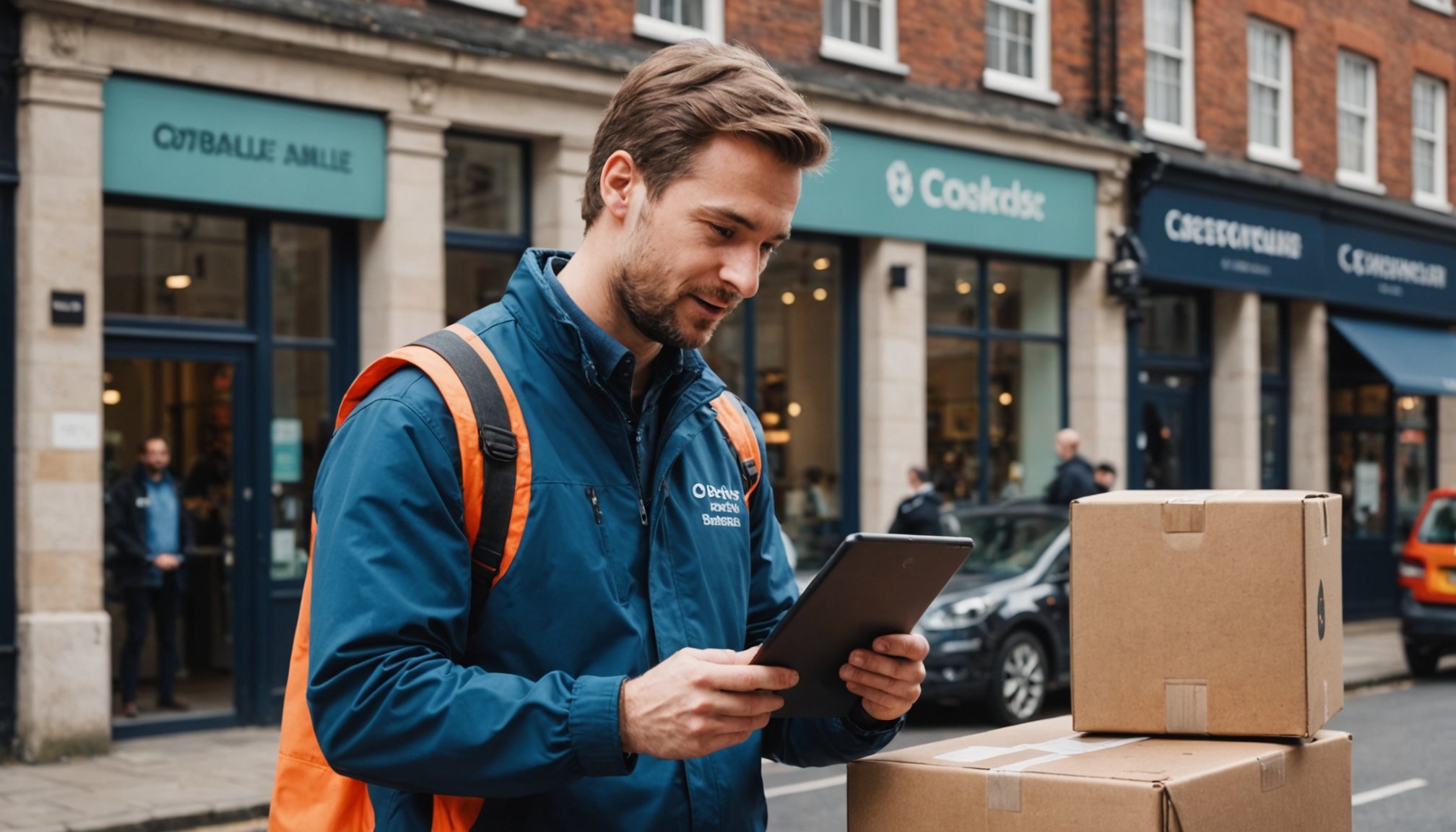Mastering Last-Mile Delivery: Strategies to Enhance E-commerce Efficiency in the UK
In the fast-paced world of e-commerce, the last mile of delivery is often the most critical and challenging phase. It is here that the customer’s expectations are either met or missed, and where logistical efficiency can make or break a business. Here, we will delve into the strategies and solutions that can help UK e-commerce businesses master the last mile and enhance their overall efficiency.
Understanding the Last Mile Delivery Challenges
The last mile of delivery, the final leg of the shipping process where goods are delivered from a transportation hub to the customer’s doorstep, is fraught with challenges. Here are some of the key issues businesses face:
Additional reading : Crucial Strategies for UK SMEs to Attain Carbon Neutrality: A Comprehensive Guide
Increased Costs
Last-mile delivery is the most expensive part of the shipping process. With the rise of free shipping and same-day delivery expectations, businesses are under pressure to keep costs down while maintaining service quality.
Complexity and Inefficiency
Urban areas present unique challenges such as traffic congestion, limited parking, and strict delivery windows. These factors can lead to increased delivery times and higher operational costs.
Topic to read : Building a Strong Cybersecurity Framework: Essential Strategies for UK E-Commerce Platforms
Customer Expectations
Customers today expect fast, reliable, and flexible delivery options. Meeting these expectations while maintaining operational efficiency is a significant challenge for e-commerce businesses.
Leveraging Advanced Fulfillment Solutions
To overcome the challenges of last-mile delivery, businesses are turning to advanced fulfillment solutions that combine technology, automation, and strategic planning.
Micro Fulfillment Centers (MFCs)
Micro Fulfillment Centers, like those offered by Fabric, are designed for urban locations and can significantly reduce last-mile costs. These compact centers support both B2C fulfillment and B2B replenishment, enabling hyper-local on-demand delivery. Here are some key features:
- Space Efficiency: Fits in as small as 15,000 square feet, ideal for unconventional urban spaces.
- Capacity: Can handle up to 200,000 units per week.
- Flexibility: Supports both standalone and in-store solutions.
Quick-Pick Solutions
Quick-Pick solutions, also from Fabric, are ideal for offering essential items and fast-moving SKUs 24/7. These solutions can be easily attached to existing stores, enabling powerful cross-channel partnerships.
- Speed: Offers 30-minute home delivery or 5-minute click and collect.
- Space: Fits in the size of one parking space.
- Deployment: Can be deployed within 12 weeks.
Optimizing Logistics with Multi-Carrier Shipping Software
Multi-carrier shipping software is a game-changer for e-commerce logistics. Here’s how it can help:
Carrier Independence
This software allows businesses to switch seamlessly between different carriers and services, ensuring that every shipment is sent at the lowest cost to meet the expected delivery time.
Automated Routing and Cost Optimization
Multi-carrier software automates the process of assigning shipments to the best carrier based on business rules, such as weight, size, and delivery location. This ensures the best rates, routes, and service levels every time.
Data Analytics and Freight Bill Auditing
The software provides data analytics to track key performance indicators like on-time and late deliveries, helping businesses identify bottlenecks and negotiate better with carriers. It also audits freight bills for accuracy, ensuring cost savings and boosting logistics ROI.
Selecting the Right LTL Carriers
For businesses that need to ship larger quantities, selecting the right Less-than-Truckload (LTL) carriers is crucial.
Assessing Shipping Needs
Before choosing an LTL carrier, it’s essential to audit current shipping practices, evaluate daily operations, and determine shipping frequencies and volumes. Here are some steps to follow:
- Audit Current Practices: Assess whether you are primarily shipping inbound to Amazon or fulfilling orders to other destinations.
- Evaluate Daily Operations: Consider how far in advance you plan your shipments and whether you can consolidate shipments to maximize efficiency.
- Determine Shipping Frequencies and Volumes: Understand your typical shipping volumes and how often you restock your inventory.
Key Criteria for LTL Carriers
When selecting an LTL carrier, consider the following criteria:
- Transit Times: Ensure the carrier can meet your desired delivery times, especially for time-sensitive products.
- Freight Tracking and Visibility: Choose a carrier that offers real-time tracking to maintain transparency and manage logistics effectively.
- Customer Service and Support: Opt for a carrier with exceptional customer support to resolve issues promptly.
Enhancing Customer Experience Through Real-Time Tracking and Delivery Options
Customer satisfaction is at the heart of any successful e-commerce business. Here’s how real-time tracking and flexible delivery options can enhance the customer experience:
Real-Time Tracking
Providing customers with real-time tracking information keeps them informed and engaged throughout the delivery process. This transparency builds trust and reduces anxiety about delivery times.
- **Example**: Amazon’s tracking system allows customers to monitor their shipments in real-time, ensuring they are always aware of the delivery status.
Flexible Delivery Options
Offering flexible delivery options such as same-day delivery, next-day delivery, and click-and-collect services caters to different customer preferences and enhances the overall delivery experience.
- **Example**: Fabric’s Quick-Pick solution offers 30-minute home delivery or 5-minute click and collect, providing customers with quick and convenient delivery options.
The Role of Technology in Last-Mile Delivery
Technology is revolutionizing the last mile of delivery, making it more efficient, cost-effective, and customer-friendly.
Proprietary Robotics and Hardware
Companies like Fabric design proprietary robotics and hardware in-house, ensuring seamless integration and minimal upkeep. This allows for tailored solutions that meet each client’s unique needs and footprint.
End-to-End Software Solutions
End-to-end software solutions optimize the entire fulfillment process, from inbound product reception to order dispatch. These solutions include customizable rules and logic, user-friendly interfaces, and seamless integration with existing systems, streamlining operations and boosting efficiency.
Future Trends: Autonomous Vehicles and Hyper-Local Delivery
As technology continues to evolve, we can expect to see more innovative solutions in last-mile delivery.
Autonomous Vehicles
Autonomous vehicles are being tested for last-mile delivery, promising to reduce labor costs and increase efficiency. While still in the experimental phase, these vehicles could revolutionize urban logistics.
- **Example**: Companies are already testing autonomous delivery vehicles in controlled environments, aiming to reduce delivery times and costs.
Hyper-Local Delivery
Hyper-local delivery solutions, such as micro fulfillment centers, are becoming more prevalent. These solutions enable businesses to offer fast and reliable delivery options, meeting the increasing demand for quick and convenient shopping experiences.
- **Example**: Fabric’s micro fulfillment centers are designed to fit into small urban spaces, enabling hyper-local on-demand delivery and pickup for e-commerce businesses.
Practical Insights and Actionable Advice
Here are some practical insights and actionable advice for enhancing last-mile delivery efficiency:
Invest in Advanced Fulfillment Solutions
Investing in advanced fulfillment solutions like micro fulfillment centers and quick-pick solutions can significantly reduce last-mile costs and improve delivery times.
- **Actionable Tip**: Assess your business needs and consider deploying micro fulfillment centers or quick-pick solutions to enhance your delivery capabilities.
Use Multi-Carrier Shipping Software
Utilize multi-carrier shipping software to optimize your shipping processes, reduce costs, and improve customer satisfaction.
- **Actionable Tip**: Implement multi-carrier shipping software to automate routing and cost optimization, and to gain data-driven insights into your logistics operations.
Focus on Customer Experience
Enhance the customer experience by providing real-time tracking information and offering flexible delivery options.
- **Actionable Tip**: Integrate real-time tracking into your delivery process and offer various delivery options to cater to different customer preferences.
Mastering the last mile of delivery is crucial for e-commerce businesses in the UK. By leveraging advanced fulfillment solutions, optimizing logistics with multi-carrier shipping software, and focusing on customer experience, businesses can enhance their operational efficiency and meet the evolving expectations of their customers.
As Fabric’s CEO notes, “Our goal is to unlock on-demand delivery and pickup for e-commerce, including grocery and health & beauty brands, by providing lightning-fast fulfillment solutions that fit any space and meet the unique needs of each client.”
In the words of a logistics expert, “The key to successful last-mile delivery is a combination of technology, strategic planning, and a deep understanding of customer needs. By investing in the right solutions and focusing on customer satisfaction, businesses can navigate the challenges of last-mile delivery and thrive in the competitive e-commerce landscape.”
By adopting these strategies and staying ahead of the curve with the latest technological advancements, UK e-commerce businesses can ensure efficient, cost-effective, and customer-centric last-mile delivery processes that drive growth and satisfaction.


















